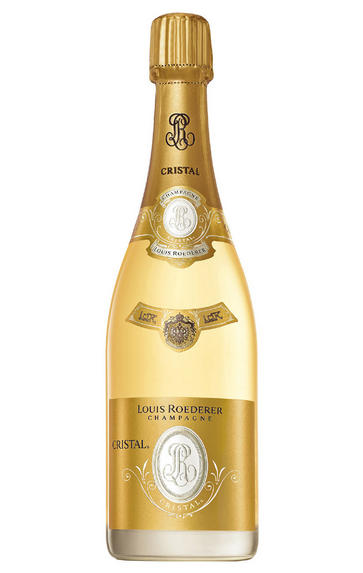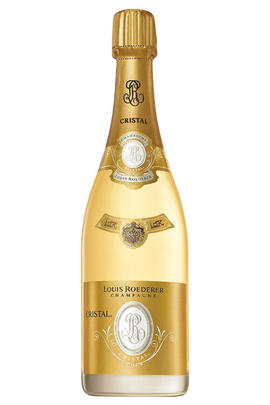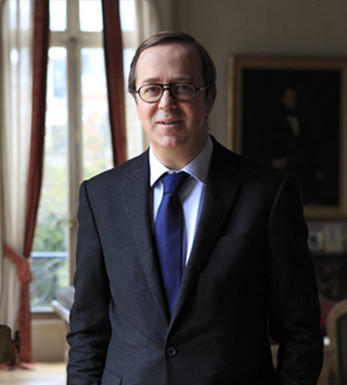
2014 Champagne Louis Roederer, Cristal, Brut

Critics reviews
The 2014 Cristal is a terrific effort that transcends the vintage. Bursting from the glass with expressive aromas of ripe citrus fruit, nectarine, white flowers, freshly baked bread and subtle hints of honeycomb, it's medium to full-bodied, vinous and fleshy, with an exuberant core of fruit that's girdled by racy acids, resulting in a wine that's simultaneously chiseled and demonstrative, meaning that early appeal doesn't come at the expense of the requisite tension for long-term cellaring. Concluding with a long, aromatic and intensely chalky finish, it is a brilliant Champagne that will offer a broad drinking window. This bottle was disgorged in June 2021 with seven grams per liter dosage.
William Kelley, Wine Advocate (Feb 2022)
An enlightened expression from a season of extremes, this has intensity, ripeness and depth of fruit that is underpinned by chalk soil-derived structure and freshness. Complex nose with lemon and grapefruit aromas, as well as closed red apple, blood orange, light biscuit spices and toasted hazelnuts. Super fresh. The palate starts pithy and fleshy with pink grapefruit, blood orange, red apple, sliced strawberry and nectarine. Expansive and mouth-filling build that is driven by concentrated fruit, Then it tightens and turns to a more mineral edge, before smoothly honed phenolics finish it long. It is 60% pinot noir and 40% chardonnay, 32% oak fermentation in those same proportions, no chaptalization, no malolactic and a dosage of 7g per liter. From organically farmed grapes. Very complex, it strikes a natural balance and is very drinkable already, though will develop well for more than a decade in the cellar.
James Suckling, JamesSuckling.com (Feb 2022)
The rollercoaster growing season of 2014 is reflected to perfection by the innate tension here; ripe citric fruit and even a touch of exoticism (mango and fig) tempered by a fine shard of acidity and a lifted ethereal character, described paradoxically by chef de caves Jean-Baptiste Lecaillon as ‘weightless density’. Purity, energy and power make for very happy bedfellows, courtesy the chalky terroir and its organic husbandry. The texture is silky, the bubbles joyfully integrated and the finish resourceful and precise, its salinity deferential to the deep-digging roots. Disgorged: June 2021. Dosage: 7g/L. Drinking Window 2022 - 2030
Simon Field MW, Decanter.com (Jan 2022)
About this WINE

Louis Roederer
Founded in 1776, Louis Roederer is a family-owned, independent Champagne house with a well-deserved reputation for quality. It is managed by Frédéric Rouzaud, the seventh generation to be at the helm.
In 1876, Louis Roederer created the now-famous Cristal at the request of Alexander II. This once intensely sweet wine is now one of the most luscious, deeply flavoured champagnes available, with the '88, '89 and '90 among the greatest Cristals ever released.
Louis Roederer’s best-selling non-vintage blend for almost 40 years, Brut Premier, has recently been replaced by Collection 242. This new multi-vintage blend was created by Chef du Caves Jean-Baptiste Lécaillon in response to increasingly warm vintages. The cuvée aims to capture freshness and is based on a perpetual reserve which focuses on acidity and minerality.

Brut Champagne
Brut denotes a dry style of Champagne (less than 15 grams per litre). Most Champagne is non-vintage, produced from a blend from different years. The non-vintage blend is always based predominately on wines made from the current harvest, enriched with aged wines (their proportion and age varies by brand) from earlier harvests, which impart an additional level of complexity to the end wine. Champagnes from a single vintage are labelled with the year reference and with the description Millésimé.
Non-vintage Champagnes can improve with short-term ageing (typically two to three years), while vintages can develop over much longer periods (five to 30 years). The most exquisite and often top-priced expression of a house’s style is referred to as Prestige Cuvée. Famous examples include Louis Roederer's Cristal, Moët & Chandon's Dom Pérignon, and Pol Roger's Cuvée Sir Winston Churchill.
Recommended Producers : Krug, Billecart Salmon, Pol Roger, Bollinger, Salon, Gosset, Pierre Péters, Ruinart

Champagne blend
Which grapes are included in the blend, and their proportion, is one of the key factors determining the style of most Champagnes. Three grapes are used - Pinot Noir, Chardonnay and Pinot Meunier.
26% of vineyards in Champagne are planted with Chardonnay and it performs best on the Côtes des Blancs and on the chalk slopes south of Epernay. It is relatively simple to grow, although it buds early and thus is susceptible to spring frosts. It produces lighter, fresher wines than those from Burgundy and gives finesse, fruit and elegance to the final blend. It is the sole grape in Blancs de Blancs, which are some of the richest long-lived Champagnes produced.
Pinot Noir accounts for nearly 40% of the plantings in Champagne and lies at the heart of most blends - it gives Champagne its body, structure, strength and grip. It is planted across Champagne and particularly so in the southern Aube district.
The final component is Pinot Meunier and this constitutes nearly 35% of the plantings. Its durability and resistance to spring frosts make the Marne Valley, a notorious frost pocket, its natural home. It ripens well in poor years and produces a soft, fruity style of wine that is ideal for blending with the more assertive flavours of Pinot Noir. Producers allege that Pinot Meunier lacks ageing potential, but this does not deter Krug from including around 15% of it in their final blends.


Buying options
Add to wishlist
Description
2014 Cristal is vibrant with aromas of grapefruit, mandarin and green apple. Biscuit, pastry and ginger come through on the palate with stone and flint notes too. The acidity is crisp and has a saline touch to it. The citrus flavours dominate currently but with time these will soften. You could drink this now but give it a few years in the cellar for more complexity to emerge from this epic Champagne. Drink 2023-2045.
Tatiana Humphreys, Senior Private Account Manager, Berry Bros. & Rudd (July 2022)
wine at a glance
Delivery and quality guarantee